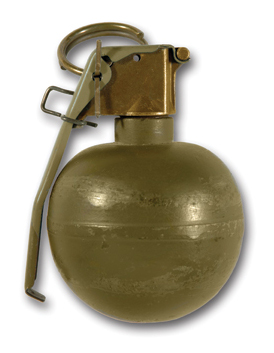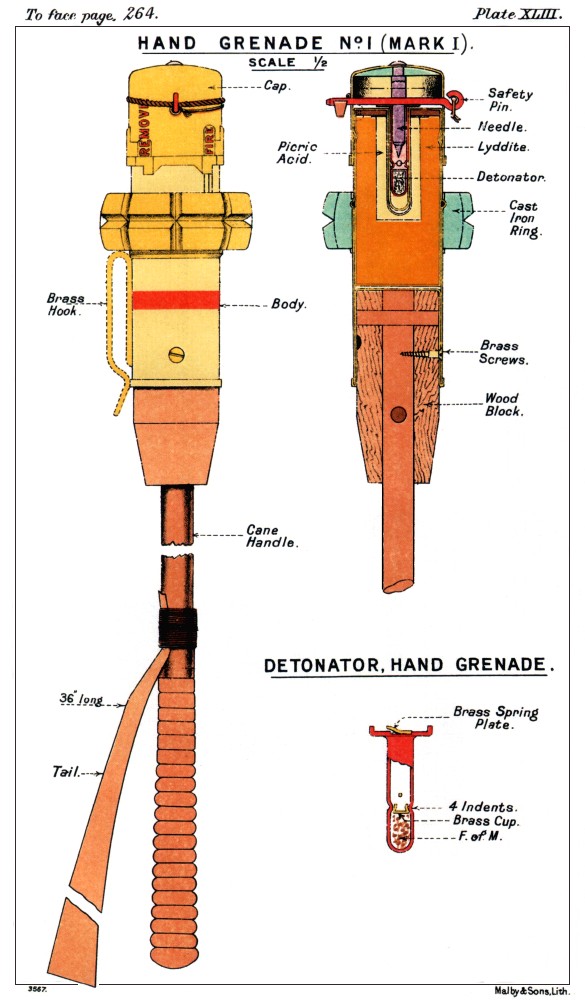|
No. 6 Grenade
The No. 6 Grenade was a hand grenade used by the United Kingdom during World War I. The No. 6 was a concussion grenade. A variant of it, called the "No. 7", contained shrapnel, making it a primitive fragmentation grenade. Pulling a loop at the top of the grenade ignited the fuse. Once the loop was pulled, the grenade was armed and had to be thrown immediately. History The No. 6 was one of the intern grenades, created because of problems associated with the No. 1 grenade. It is one of the few intern grenades that uses a friction-based lighting system. While this seemed fine in theory, in practice it had multiple problems. The most prominent of all was that the arming method did not work as intended. In many cases pulling the loop was too difficult for one man to do and it required two men. For a lone soldier, the best method was to hold the grenade between the knees and pull on the loop with both hands. However, this often resulted in cutting the fingers in addition to igniting t ... [...More Info...] [...Related Items...] OR: [Wikipedia] [Google] [Baidu] |
World War I
World War I (28 July 1914 11 November 1918), often abbreviated as WWI, was one of the deadliest global conflicts in history. Belligerents included much of Europe, the Russian Empire, the United States, and the Ottoman Empire, with fighting occurring throughout Europe, the Middle East, Africa, the Pacific, and parts of Asia. An estimated 9 million soldiers were killed in combat, plus another 23 million wounded, while 5 million civilians died as a result of military action, hunger, and disease. Millions more died in genocides within the Ottoman Empire and in the 1918 influenza pandemic, which was exacerbated by the movement of combatants during the war. Prior to 1914, the European great powers were divided between the Triple Entente (comprising France, Russia, and Britain) and the Triple Alliance (containing Germany, Austria-Hungary, and Italy). Tensions in the Balkans came to a head on 28 June 1914, following the assassination of Archduke Franz Ferdin ... [...More Info...] [...Related Items...] OR: [Wikipedia] [Google] [Baidu] |
Hand Grenade
A grenade is an explosive weapon typically thrown by hand (also called hand grenade), but can also refer to a shell (explosive projectile) shot from the muzzle of a rifle (as a rifle grenade) or a grenade launcher. A modern hand grenade generally consists of an explosive charge ("filler"), a detonator mechanism, an internal striker to trigger the detonator, and a safety lever secured by a cotter pin. The user removes the safety pin before throwing, and once the grenade leaves the hand the safety lever gets released, allowing the striker to trigger a primer that ignites a fuze (sometimes called the delay element), which burns down to the detonator and explodes the main charge. Grenades work by dispersing fragments (fragmentation grenades), shockwaves (high-explosive, anti-tank and stun grenades), chemical aerosols (smoke and gas grenades) or fire ( incendiary grenades). Fragmentation grenades ("frags") are probably the most common in modern armies, and when the word ''gre ... [...More Info...] [...Related Items...] OR: [Wikipedia] [Google] [Baidu] |
Concussion Grenade
A grenade is an explosive weapon typically thrown by hand (also called hand grenade), but can also refer to a Shell (projectile), shell (explosive projectile) shot from the muzzle of a rifle (as a rifle grenade) or a grenade launcher. A modern hand grenade generally consists of an explosive charge ("filler"), a detonator mechanism, an internal Firing pin, striker to trigger the detonator, and a safety lever secured by a split pin, cotter pin. The user removes the safety pin before throwing, and once the grenade leaves the hand the safety lever gets released, allowing the striker to trigger a Percussion cap, primer that ignites a fuze (sometimes called the delay element), which burns down to the detonator and explodes the main charge. Grenades work by dispersing fragments (fragmentation grenades), shockwaves (High explosive, high-explosive, Anti-tank grenade, anti-tank and stun grenades), chemical aerosols (Smoke grenade, smoke and gas grenades) or fire (incendiary grenades). Fr ... [...More Info...] [...Related Items...] OR: [Wikipedia] [Google] [Baidu] |
Fragmentation Grenade
A grenade is an explosive weapon typically thrown by hand (also called hand grenade), but can also refer to a shell (explosive projectile) shot from the muzzle of a rifle (as a rifle grenade) or a grenade launcher. A modern hand grenade generally consists of an explosive charge ("filler"), a detonator mechanism, an internal striker to trigger the detonator, and a safety lever secured by a cotter pin. The user removes the safety pin before throwing, and once the grenade leaves the hand the safety lever gets released, allowing the striker to trigger a primer that ignites a fuze (sometimes called the delay element), which burns down to the detonator and explodes the main charge. Grenades work by dispersing fragments (fragmentation grenades), shockwaves (high-explosive, anti-tank and stun grenades), chemical aerosols (smoke and gas grenades) or fire (incendiary grenades). Fragmentation grenades ("frags") are probably the most common in modern armies, and when the word ''grenad ... [...More Info...] [...Related Items...] OR: [Wikipedia] [Google] [Baidu] |
No 1 Grenade
The Grenade, Hand, No. 1 was the first British hand grenade used in World War I. It was designed in the Royal Laboratory, based on reports and samples of Japanese hand grenades during the Russo-Japanese War provided by General Sir Aylmer Haldane, who was a British observer of that war. The grenade proper is a container of explosive material with an iron fragmentation band. The fuse was of the impact sort, detonating when the top of the grenade hit the ground. A long cane handle (approximately 16 inches or 40 cm) allowed the user to throw the grenade further than the blast of the explosion. To ensure that the grenade hit the ground nose first, a cloth streamer was attached to the end of the handle. When thrown, this unfurled and acted as a tail to stabilize flight. The grenade came with a metal loop so it could hang from a belt. In the trenches When the battlefield became confined to the trenches, the long handle became a liability, causing several accidents. Reac ... [...More Info...] [...Related Items...] OR: [Wikipedia] [Google] [Baidu] |
Percussion Cap
The percussion cap or percussion primer, introduced in the early 1820s, is a type of single-use percussion ignition device for muzzle loader firearm locks enabling them to fire reliably in any weather condition. This crucial invention gave rise to the cap lock mechanism or percussion lock system using percussion caps struck by the hammer to set off the gunpowder charge in percussion guns including percussion rifles and cap and ball firearms. Any firearm using a caplock mechanism is a percussion gun. Any long gun with a cap-lock mechanism and rifled barrel is a percussion rifle. Cap and ball describes cap-lock firearms discharging a single bore-diameter spherical bullet with each shot. Description The percussion cap is a small cylinder of copper or brass with one closed end. Inside the closed end is a small amount of a shock-sensitive explosive material such as mercuric fulminate (discovered in 1800; it was the only practical detonator used from about 1850 to the early 20th ... [...More Info...] [...Related Items...] OR: [Wikipedia] [Google] [Baidu] |
Fragmentation (weaponry)
Fragmentation is the process by which the casing, shot, or other components of an anti-personnel weapon, bomb, barrel bomb, land mine, IED, artillery, mortar, tank gun, or autocannon shell, rocket, missile, grenade, etc. are dispersed and/or shattered by the detonation of the explosive filler. The correct term for these pieces is "fragmentation"; "shards" or "splinters" can be used for non-preformed fragments. Preformed fragments can be of various shapes (spheres, cubes, rods, etc.) and sizes, and are normally held rigidly within some form of matrix or body until the high explosive (HE) filling is detonated. The resulting high-velocity fragments produced by either method are the main lethal mechanisms of these weapons, rather than the heat or overpressure caused by detonation, although offensive grenades are often constructed without a frag matrix. These casing pieces are often incorrectly referred to as "shrapnel", particularly by non-military media sources. History The ... [...More Info...] [...Related Items...] OR: [Wikipedia] [Google] [Baidu] |
World War I Grenades Of The United Kingdom
In its most general sense, the term "world" refers to the totality of entities, to the whole of reality or to everything that is. The nature of the world has been conceptualized differently in different fields. Some conceptions see the world as unique while others talk of a "plurality of worlds". Some treat the world as one simple object while others analyze the world as a complex made up of many parts. In ''scientific cosmology'' the world or universe is commonly defined as " e totality of all space and time; all that is, has been, and will be". '' Theories of modality'', on the other hand, talk of possible worlds as complete and consistent ways how things could have been. ''Phenomenology'', starting from the horizon of co-given objects present in the periphery of every experience, defines the world as the biggest horizon or the "horizon of all horizons". In ''philosophy of mind'', the world is commonly contrasted with the mind as that which is represented by the mind. ''Th ... [...More Info...] [...Related Items...] OR: [Wikipedia] [Google] [Baidu] |
Concussion Grenades
A concussion, also known as a mild traumatic brain injury (mTBI), is a head injury that temporarily affects brain functioning. Symptoms may include loss of consciousness (LOC); memory loss; headaches; difficulty with thinking, concentration, or balance; nausea; blurred vision; sleep disturbances; and mood changes. Any of these symptoms may begin immediately, or appear days after the injury. Concussion should be suspected if a person indirectly or directly hits their head and experiences any of the symptoms of concussion. It is not unusual for symptoms to last 2 weeks in adults and 4 weeks in children. Fewer than 10% of sports-related concussions among children are associated with loss of consciousness. Common causes include motor vehicle collisions, falls, sports injuries, and bicycle accidents. Risk factors include drinking alcohol and a prior history of concussion. The mechanism of injury involves either a direct blow to the head or forces elsewhere on the body that are t ... [...More Info...] [...Related Items...] OR: [Wikipedia] [Google] [Baidu] |




